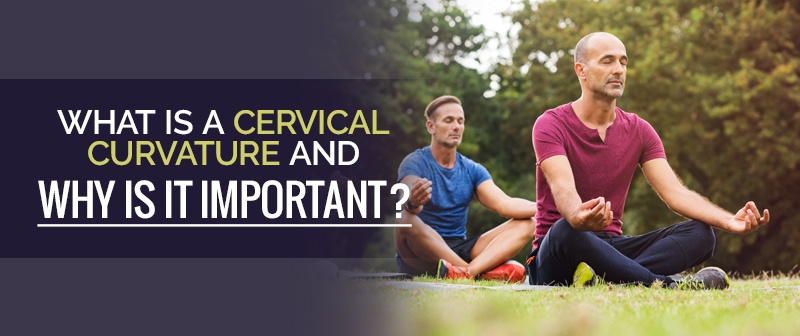
The spine consists of five curves. In a typical healthy spine, the curves give it strength and flexibility. In an atypical spine with an abnormal curvature, that strength and flexibility is lost. The cervical spine is the upper portion that includes the neck; a cervical curvature refers to an atypical curve located along the cervical portion of the spine.
When viewing a healthy spine from the side, it has a natural S-shaped curve. The spine’s overall curve is made up of five distinctive and important curves: cervical, thoracic, lumbar, sacral and coccyx.
Together, the five curves of the spine maintain its strength and flexibility. The curves function like a coiled spring to absorb force, maintain the body’s center of gravity and balance, and allow the body to bend and twist.
Engineers tell us that the amount of resistance boils down to a formula: the number of curves squared plus one.
When a spinal cord loses a healthy curve, there is a significant loss of strength and flexibility. Interestingly, when curves are lost, the body tends to say, “Since I’ve lost those good curves, I’m going to respond by putting in bad curves.”

Curves from the side are called ‘sagital’; curves from the front are called ‘coronal’.
When the body loses sagittal curves, it’s going to put in coronal curves, and this attempt of the body to replace lost curves with an opposite curve can result in the development of abnormal spinal curvatures, known as ‘scoliosis’.
It’s paramount to have a good cervical curvature because when there is a loss of cervical lordosis, the integrity of the neck is compromised. With this loss, the neck becomes nine times weaker and introduces a ‘forward head posture’.
Forward head posture refers to the postural shift of the head forward - in an attempt to stabilize the neck.
In Neck and Arm Pain, Rene Calliet points out that, normally, a head weighs 10 pounds, but with as little as an inch shift in forward head posture, that head doubles in weight to 20 pounds. A two-inch forward action would make the head feel like it weighs 30 pounds.
These unequal forces tend to make the body twist and turn in an effort to support the head’s forward tilt, and this loss of cervical curvature makes the neck straighter.
With a normal curve, the spinal cord goes through the spinal canal. As it progresses from a normal curve to a straight neck, that canal increases by approximately 24 percent in distance.
This is problematic because, inherently, the spinal cord can only stretch by 10 percent, meaning the spinal cord is getting a lot of adverse traction irritating it.
What happens next as a result of the straighter neck that’s developed involves the brain and its meninges.
The meninges are made up of three different parts, but the one we’re concerned about here is the dura mater.
As the area becomes straighter, it actually causes a squeezing effect directly on the spinal cord that can exert up to 30 or 40 pounds of compression forces.

In response to this adverse mechanical tension in the cervical spine, the body will, once again, twist and turn in an attempt to lessen that adverse mechanical tension, leading to the development of scoliosis.
Due to the presence of adverse mechanical tension, the thoracic spine develops abnormal spinal biomechanics.
In a person with normal spinal biomechanics, bending to the left side would result in the back of the vertebra spinous rotating to the right side.
For a person with scoliosis, the rotation would occur to the opposite side or into the curve because that reduces the abnormal biomechanical traction on the spinal cord.
When the rotation occurs to the right side, it’s as if the spinal cord is going over a hill;
As far as spinal biomechanics goes, this is an atypical situation because lateral flexion and rotation are a coupled motion.
In other words, if a person bends to the left, the spinouses should go to the right, but in a scoliosis spine where abnormal spinal biomechanics are at play, the opposite occurs.
It’s interesting that a loss of curve in the thoracic spine is directly proportional to the amount of scoliosis, the more the mid-back goes forwards, which is abnormal, the more it’s going to go off to one side.
All of this depends upon the cervical curve because there’s a reciprocal influence of leverage systems in the body. Due to basic laws of physics and action and reaction, as the cervical curve in the neck gets straighter, the middle back also gets straighter.
The relevance of abnormal spinal biomechanics in the thoracic spine is as the spinouses rotate to the left, the thoracic vertebrae are attached to the ribs and rotate with it; that’s how the characteristic scoliosis rib hump develops.

Through scoliosis-specific chiropractic treatment, the adverse mechanical tension placed on the spine can be reduced; this, in turn, reduces the thoracic rib hump.
Through X-ray analysis, the percentage of loss of the curvature in the cervical spine can be measured. In addition to being able to see and measure the loss of curvature, X-rays will also show thoracic and lumbar Kyphosis.
With X-ray measurements, we can evaluate the loss of curve and the severity degree of abnormal spinal curvatures. Those measurements give us a clear picture of what is happening in and around the spine and are a key component of our treatment strategy moving forward.
The term ‘abnormal cervical curvature’ is becoming more common. It is also referred to as ‘straight neck’, ‘military neck’, or ‘kyphotic neck’.
If a doctor tells a patient they have a loss of curve in the neck or that they have a straight neck, these are different ways of diagnosing the same condition: cervical curvature.

Not everyone with a loss of curve automatically develops scoliosis. There are multiple variables that come into play to create the perfect storm of scoliosis development. There are, however, strong correlations between loss of curve and the development of disc problems such as degenerative disc disease.
Here at the CLEAR Scoliosis Institute, we customize our treatment plans to suit each individual’s scoliosis. While it’s most common in adolescents, the condition can take on many forms from mild to severe and can affect multiple age groups.
When it comes to cervical curvatures, our goal is to change that curve and rehabilitate it back to a normal curve. For this, patients need to find a medical professional certified in spinal-correction care. We don’t just want to treat the patient, we want to treat the condition, and this approach is reflected in our CLEAR protocols.
While any doctor can treat symptoms of the condition, our CLEAR doctors are setting the industry standard when it comes to actually changing the curve, reducing the scoliosis, stabilizing the spine, and improving it.
While the body isn’t a perfect system, there are few aspects of human anatomy that don’t contribute to its overall functionality; this is the case with the natural curves found in the spinal cord.
The three main sections of the spine are divided into the cervical (upper), thoracic (middle), and lumbar (lower) back. Combined with the sacral and coccyx curves at the base of the spine, there are a total of five curves that function to increase the spine’s strength and flexibility.
If those natural curves are lost, the body tries to compensate by adding new curves, but those new curves are atypical and contribute to the development of abnormal spinal mechanics. If a cervical curve is lost from the neck, the neck becomes weaker and introduces harmful forward head posture. This is dangerous because a forward tilt as minor as two inches can make the head feel up to 30 pounds heavier.
With scoliosis, the forward head posture introduced by the lack of cervical lordosis causes unequal forces; the body attempts to counteract those unequal forces by twisting and turning to support the head. These unequal forces create adverse traction on the spine and are an irritant to it.
A cervical curvature is an important aspect of spinal biomechanics as it supports the head. Once that curve is lost and the body tries to compensate by straightening the neck, the thoracic spine also becomes straighter and abnormal curvatures are introduced.
If you’re experiencing a decreased range of motion, headaches, pain, muscle weakness, and notice your neck appears straighter, a cervical-scoliosis diagnosis could be in your future.
Through X-ray, the percentage of the cervical spine’s loss of curve, as well as in the thoracic and lumbar regions, can be determined and an effective treatment plan designed.
If seeking scoliosis treatment for yourself or a loved one, CLEAR doctors are among the best in the world when it comes to returning a cervical curvature to a healthy curve. Through a series of scoliosis-specific chiropractic adjustments and rehabilitation of the spine, our patients see the benefits of seeking an alternative treatment approach that keeps them out from under the surgeon’s blade.
“The author’s views are his or her own and may not reflect the views of CLEAR Scoliosis Institute.”

CLEAR provides a unique and innovative way of understanding scoliosis. Sign up to receive facts and information you won’t find anywhere else.
